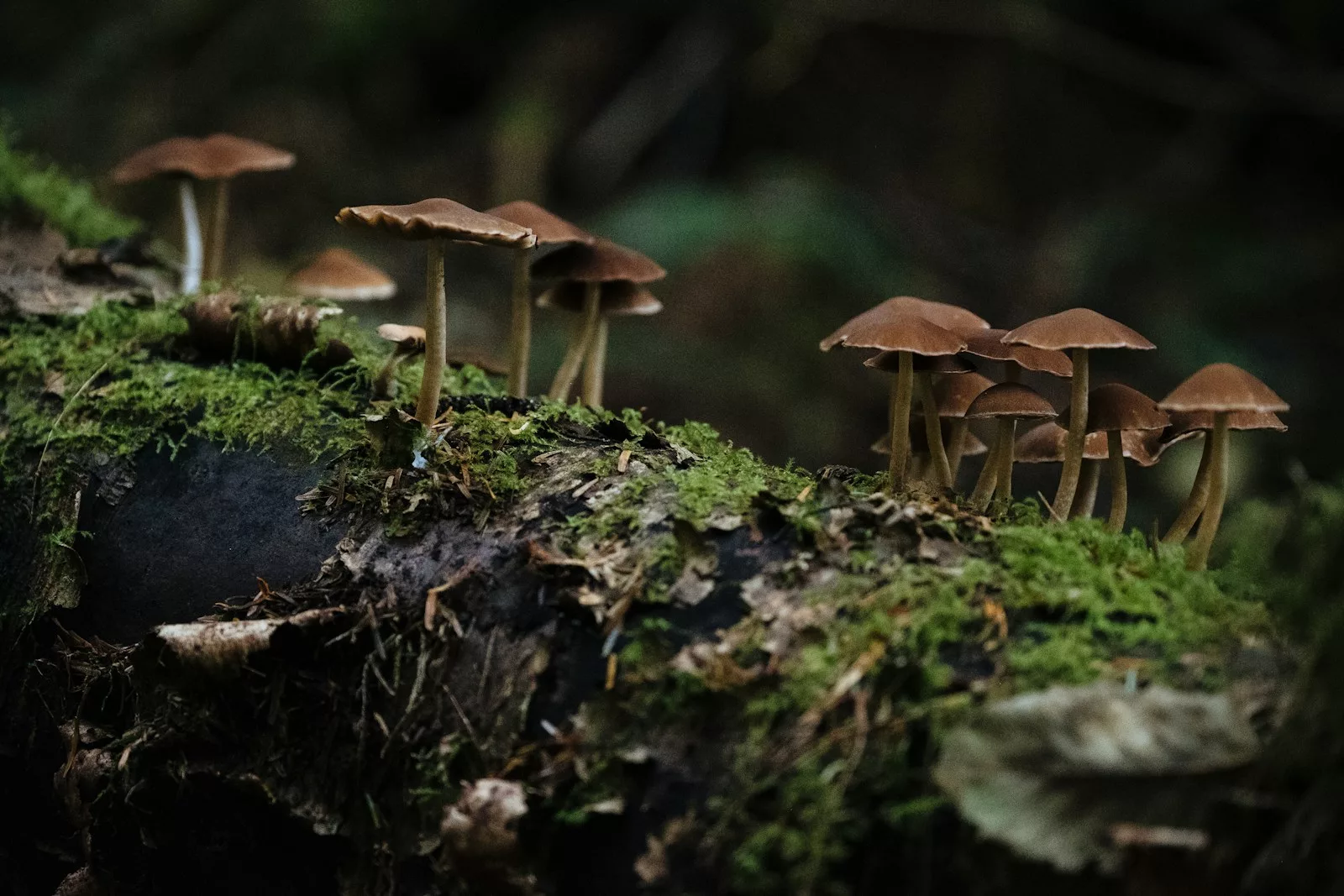Fungi are some of the most fascinating and mysterious organisms on Earth. They are neither plants nor animals, and they exist in an entirely separate biological kingdom. From glowing mushrooms to fungi that control the minds of insects, these organisms play crucial roles in ecosystems, medicine, and even human history. Many of their abilities defy what we think we know about nature, making them one of the most extraordinary life forms on the planet. Despite often being overlooked in favor of plants and animals, fungi are among the most ecologically and biologically significant organisms in the natural world. Their ability to break down organic material, form complex underground networks, and even alter animal behavior makes them indispensable players in Earth’s ecosystems.
1. Fungi Are More Closely Related to Animals Than Plants
Although fungi were once classified as plants, genetic studies have revealed that they share more DNA with animals than with plants. Unlike plants, fungi do not perform photosynthesis; instead, they obtain nutrients by breaking down organic matter, much like animals digest food. This evolutionary connection means that fungi and humans share certain biological similarities, such as how they process energy and build cellular structures.
One major similarity between fungi and animals is the presence of chitin, a tough structural compound that makes up fungal cell walls and is also found in the exoskeletons of insects and crustaceans. Fungi also store energy in the form of glycogen, just like animals do, whereas plants store energy as starch. These shared traits highlight just how unique fungi are in the tree of life and reinforce their deep evolutionary ties to the animal kingdom.
2. The Largest Living Organism on Earth Is a Fungus
A single specimen of Armillaria ostoyae, a type of honey fungus, holds the title of the largest living organism on Earth. Found in the Blue Mountains of Oregon, this massive underground fungal network spans over 3.8 square miles (9.8 square kilometers) and is estimated to be thousands of years old. While it appears as small mushrooms on the surface, beneath the ground, its mycelial network connects across vast distances, making it the true giant of the natural world.
Unlike trees or animals that have a single, centralized body, fungi expand outward through mycelium, a dense web of root-like structures that absorb nutrients from the environment. This underground network allows fungi to spread over massive areas while remaining largely invisible. The Armillaria fungus continues to grow and expand, feeding on decaying wood and tree roots. Over time, it has become an ecosystem engineer, influencing plant growth and shaping the forest’s ecological balance.
3. Some Fungi Glow in the Dark
Bioluminescent fungi produce a mesmerizing green glow due to a chemical reaction involving luciferin, luciferase, and oxygen—similar to how fireflies generate light. Scientists believe this glowing effect helps attract insects that spread fungal spores, aiding reproduction. Over 80 species of bioluminescent fungi exist, with Mycena chlorophos and Panellus stipticus being among the most famous glow-in-the-dark mushrooms.
Some bioluminescent fungi, such as Neonothopanus gardneri, produce light bright enough to be seen in dense forests at night. The phenomenon, known as foxfire, has been observed for centuries, with early records describing glowing wood in dark forests. While researchers continue to explore the exact purpose of fungal bioluminescence, one prevailing theory suggests that it may help fungi attract spore-dispersing insects or deter predators.
4. There Are Fungi That Turn Insects Into Zombies
The Ophiocordyceps fungus is known for its horrifying ability to infect insects and take control of their bodies. After an ant or other insect becomes infected, the fungus manipulates its behavior, compelling it to climb to a high point before the fungus bursts out of the host’s body, releasing spores to infect new victims. This eerie mind-control mechanism has inspired horror stories and even elements in video games like The Last of Us.
Scientists have discovered multiple species of Ophiocordyceps, each specialized to target a specific type of insect. Some fungi even alter the host’s internal chemistry, keeping it alive just long enough to ensure successful spore dispersal. While these fungi may seem like something out of a science fiction nightmare, they play a crucial role in natural population control, preventing insect species from becoming too dominant in an ecosystem.
5. Fungi Can Survive in Space
Experiments on the International Space Station have shown that certain fungi, such as Cryptococcus neoformans, can survive extreme radiation, microgravity, and the vacuum of space. Some fungi even thrive in these harsh conditions by using melanin to protect themselves from radiation. Scientists are studying space-resistant fungi to understand how life might survive on other planets and whether fungi could be useful for space colonization.
In 2019, researchers discovered that fungi from the Chernobyl disaster zone exhibited unique properties that allowed them to thrive in highly radioactive environments. These findings have led to speculation that fungi could be used to develop radiation-shielding technology for future space missions. Some scientists even believe that extremophilic fungi could be among the first organisms capable of surviving on Mars, providing insights into the possibilities of extraterrestrial life.
6. Some Mushrooms Can Absorb Radiation
Following the Chernobyl nuclear disaster, scientists discovered that certain fungi, such as Cladosporium sphaerospermum, thrive in radioactive environments. These fungi use melanin to absorb radiation and convert it into chemical energy, a process similar to photosynthesis but using ionizing radiation instead of sunlight. This unique adaptation has led researchers to explore the potential of these fungi for bioremediation, potentially helping to clean up radioactive waste sites.
Beyond Earth, these radiation-resistant fungi are also being studied for their potential applications in space travel. Some researchers speculate that fungi capable of withstanding high radiation levels could be used to develop protective shielding for astronauts or even grow food in extreme environments such as Mars. Their remarkable ability to survive harsh conditions opens up possibilities for both environmental cleanup and future space colonization efforts.
7. Truffles Are Among the Most Expensive Foods in the World
Truffles, the underground fruiting bodies of certain fungi, are among the most sought-after and expensive culinary delicacies. White truffles from Italy can sell for thousands of dollars per pound, with rare specimens fetching auction prices that rival fine jewelry. Their rarity is due to their symbiotic relationship with tree roots, requiring very specific environmental conditions to grow.
Because truffles grow underground, trained dogs and pigs are used to sniff them out. Their pungent aroma is thought to mimic pheromones, which attract animals that help spread their spores. Truffles have been cherished for centuries and continue to be a symbol of luxury dining, with chefs using them sparingly to enhance dishes with their earthy, umami-rich flavor.
8. Fungi Form Underground Networks That Help Trees Communicate
Fungi play a crucial role in forests by forming underground networks that connect tree roots, often referred to as the “Wood Wide Web.” Mycorrhizal fungi establish symbiotic relationships with plants, exchanging nutrients in return for sugars. Through this network, trees can send chemical signals to warn each other about pests, share resources, and even support weaker trees by transferring nutrients.
This complex communication system allows forests to function as interconnected communities rather than isolated individuals. Scientists have only begun to understand the extent of these interactions, but their findings suggest that fungi play a key role in maintaining forest health and resilience. Some researchers believe that studying these networks could inspire new forms of decentralized communication and resource-sharing technologies.
9. Some Fungi Can Be Used to Create Sustainable Materials
Fungi are not only essential for natural ecosystems but also hold promise for sustainable materials. Mycelium, the root-like structure of fungi, can be grown into biodegradable packaging, leather alternatives, and even building materials. Companies are exploring ways to replace plastic and synthetic materials with mycelium-based products that are fully compostable and environmentally friendly.
In addition to replacing traditional materials, mycelium has been used to create bricks stronger than concrete, making it a potential future resource for sustainable architecture. The ability of fungi to grow rapidly and form dense, durable structures means that they could revolutionize industries ranging from fashion to construction, reducing our reliance on environmentally harmful materials.
10. Some Fungi Produce Natural Insecticides
Certain fungi, such as Beauveria bassiana and Metarhizium anisopliae, act as natural insect killers by infecting and eliminating pest populations. These fungi produce spores that attach to insects, penetrate their exoskeletons, and eventually consume them from the inside out. Unlike chemical pesticides, fungal-based insecticides are environmentally friendly and pose minimal risk to beneficial insects such as bees.
Scientists are developing fungal biopesticides to combat agricultural pests in a way that reduces reliance on synthetic chemicals. These fungi are being used to control invasive species like locusts and mosquitoes, offering a promising alternative to conventional pesticides. As concerns about pesticide resistance and environmental damage grow, fungal-based pest control solutions may become a crucial part of sustainable agriculture and ecosystem management.
11. Some Fungi Can Digest Plastic
With the growing concern over plastic pollution, scientists have discovered fungi capable of breaking down plastic materials. Pestalotiopsis microspora, a fungus found in the Amazon rainforest, can digest polyurethane, one of the most common plastics used in manufacturing. This discovery has sparked interest in using fungi for bioremediation to help clean up plastic waste in landfills and oceans.
Researchers are also studying fungi like Aspergillus tubingensis, which can degrade synthetic materials much faster than previously thought possible. If successfully developed on a large scale, fungal-based plastic degradation could offer a sustainable solution to one of the world’s most pressing environmental problems.
12. Some Fungi Create “Fairy Rings”
Fairy rings are mysterious circular formations of mushrooms that appear in forests, grasslands, and even lawns. These rings form as the underground mycelium spreads outward, depleting nutrients in the center and causing new mushrooms to sprout along the edges. Some rings can grow for centuries, with diameters stretching over 30 feet (9 meters).
In folklore, fairy rings were often associated with supernatural beings like elves and fairies, believed to be portals to other realms. While science has debunked the mythological explanations, the phenomenon of fairy rings remains one of the most intriguing natural occurrences linked to fungi.
13. Some Fungi Can Survive Extreme Cold
Certain fungi have adapted to survive in some of the coldest places on Earth, including Antarctica and the Arctic. Cryophilic (cold-loving) fungi can remain active in subzero temperatures, using antifreeze-like proteins to prevent ice crystals from damaging their cells. These fungi play a crucial role in breaking down organic matter in frozen environments, contributing to nutrient cycles.
Understanding how these fungi survive extreme cold could lead to advancements in cryopreservation technology and even insights into how life might persist in icy environments on other planets, such as Jupiter’s moon Europa.
14. Psychedelic Fungi Have Shaped Human Culture
Hallucinogenic mushrooms, such as Psilocybe cubensis, contain psilocybin, a compound that induces altered states of consciousness. Used for centuries in religious and spiritual ceremonies, these fungi have had a profound impact on human culture, influencing art, mythology, and even modern psychology.
Recent studies suggest that psilocybin mushrooms may have therapeutic potential for treating depression, PTSD, and anxiety. Researchers are now exploring their ability to reset brain activity and improve mental well-being, making psychedelic fungi one of the most exciting frontiers in mental health research.
15. Some Fungi Can “Breathe” Metals
Certain fungi, such as Fusarium oxysporum, have the ability to extract and process metals from their environment. This process, known as biomining, allows fungi to convert toxic metals into non-harmful forms or even extract valuable metals like gold from electronic waste.
Scientists are investigating how these metal-metabolizing fungi could be used to clean up heavy metal contamination in polluted environments. This natural process could provide an eco-friendly alternative to traditional mining and waste management techniques.
16. The Oldest Known Fungal Fossils Date Back Over a Billion Years
Fossilized fungal remains dating back over a billion years have been discovered, suggesting that fungi played a crucial role in shaping early life on Earth. Some of the earliest fungi likely contributed to soil formation by breaking down rocks, paving the way for plant life to emerge.
The discovery of ancient fungi has also led to speculation about their role in early ecosystems and the possibility that fungi could have been among the first complex organisms to colonize land. Their long evolutionary history highlights their resilience and adaptability, making them one of the oldest and most enduring life forms on the planet.
Conclusion
Fungi are far more than just mushrooms growing in the woods—they are essential to life on Earth, capable of astonishing feats that challenge our understanding of biology. From their role in medicine to their mind-controlling abilities, these bizarre organisms continue to intrigue scientists and nature lovers alike. The next time you see a mushroom, remember that you’re looking at one of nature’s most remarkable creations. Their ability to break down organic matter, form symbiotic relationships, and survive in extreme environments makes fungi one of the most resilient and influential groups of organisms on our planet.




